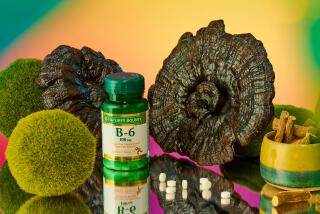A Jolt to the Health Conscious : Full of Sugar and Caffeine, Cola May Liven Laid-Back Southland
- Share via
Phillip Sontag, an account coordinator at a Los Angeles public relations firm, used to drink three cups of coffee daily to stay alert at his job. But he says he’s found a more tasty alternative for his daily dose of caffeine: Jolt Cola.
In making the switch to the sugary, caffeine-laden Jolt, Sontag--who describes himself as health conscious and who heard about it on a local radio station--has become as much of a contradiction as the beverage he consumes. At a time when other beverage makers are stressing the nutritional value of their product, Jolt Co. is thumbing its nose at the trend by marketing a cola with “all the sugar and twice the caffeine” of other brands.
“Soft drinks were not intended to be health foods, they are supposed to be refreshing and lots of fun,” said C. J. Rapp, the 28-year-old president of Jolt, based in Rochester, N.Y. “The American consumer has turned more health conscious. But we’re finding that consumers are really of two different natures. . . . Consumers are very conscious of appearance but they’re also looking for something for a replacement of energy.”
Southern California consumers like Sontag could well decide the fate of Jolt, which became available in Southern California only two months ago. That’s because although Southern California consumers have a reputation for being health conscious, those same consumers make up the biggest soft drink market in the world.
“Southern California is a crucial market,” said Ted Molakides, president of San Francisco-based Golden Brands Market, which distributes Jolt in California and Nevada. “There are 30 million people here and the average consumer probably drinks 44 gallons of soft drinks a year.”
To reach the Southern California’s youth market, Jolt has launched an outdoor advertising campaign on about 50 billboards. The advertisements show a man, with his hair on end, like he is being electrocuted, saying: “Jolt Cola. For those that dare to want it all!”
Jolt currently is seeking about $10 million in venture capital financing to fund a nationwide television advertising campaign, Rapp said.
For more than a year, Jolt has flourished without having to mount any advertising campaign at all.
Introduced in the wake of Coca-Cola’s ill-fated introduction of New Coke, Jolt received widespread coverage from newspapers and television stations when it appeared in Rochester in April, 1986, with only three employees and a paltry $100,000 advertising budget.
Quickly Sold Out
In the first few weeks in Rochester, consumers quickly emptied store shelves of the product even though some consumer advocates, such as Michael S. Jacobson, executive director of the Center for Science in the Public Interest, decried Jolt as “a legal product that is absolute nutritional junk.”
Each 12-ounce can of Jolt contains 71 milligrams of caffeine (twice the amount in other regular colas but about one-third the amount in a cup of coffee), about 10 teaspoons of sugar and 167 calories. In the fall, the company will begin marketing a diet version, called Jolt 25, which will be sweetened with sugar and NutraSweet and have 25 calories per 12-ounce can.
But as the novelty wears off, Jolt will have to rely on its own marketing strengths to compete against soft drink giants such as Coca-Cola and Pepsi.
The cutthroat competition nearly crippled another soft drink company, A. J. Canfield Co. of Chicago, which suddenly found itself unable to meet the huge demand for its diet chocolate fudge soda after a favorable column in a local newspaper.
Temporarily finding itself without a franchising plan and unwilling to spend money to expand production capacity in Chicago, Canfield ended up settling for a regional share of the national soft drink market as a host of imitators quickly began offering chocolate or fudge flavored sodas, including cookie makers Famous Amos and Mrs. Fields.
Uses Beer Distributors
But Jolt hopes to avoid some of the problems Canfield faced with distribution and supply by using a novel distribution system. Although Jolt is bottled by its soft drink competitors in some areas, the product is being distributed mainly through a vast network of beer distributors, such as Golden Brands, rather than through the soft drink network, which is largely controlled by Pepsi-Cola, Coca-Cola and Seven-Up.
“When the demand for Jolt began to pick up, we decided the key was to service retailers the best way we can,” Rapp said. “The beauty of our distribution system is that regardless of how many soft drinks they sell, it doesn’t conflict with beer sales. I think that’s why we’ve been so successful.”
JOLT COLA: WHAT’S IN IT?
“All the sugar and twice the caffeine,” says Jolt Co. Specifically, a 12-ounce can contains about 10 teaspoons of cane sugar and has 167 calories.
As for caffeine, it has 71 milligrams per can, or 5.9 milligrams per ounce. That’s just short of the 6.0 milligram maximum level set by the U.S. Food and Drug Administration for soft drinks. The caffeine level is about twice that of most soft drinks with caffeine, Jolt says, but only a third that of coffee.
And, what else is in there? Carbonated water, caramel color, phosphoric acid, citric acid and natural flavor.
More to Read
Inside the business of entertainment
The Wide Shot brings you news, analysis and insights on everything from streaming wars to production — and what it all means for the future.
You may occasionally receive promotional content from the Los Angeles Times.









